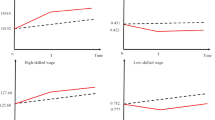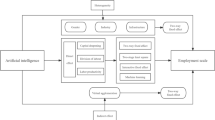Abstract
Automation impacts wage levels at the micro-level and the structure of employment at the macro-level. Job polarisation is defined as the automation of ‘middle-skilled’ jobs that require routine cognitive and manual applications, whilst high- and low-skilled occupations are preserved. This paper examines the nature of job polarisation in India during the period 1983–2012 when Indian manufacturing sector was being automated. The research uses disaggregated data from National Sample Survey Office and examines the impact of supply-side factors such as nature of employment and presence of educated labour force. The study has three observations. First, the increased demand for high-skilled workers in the formal manufacturing sector is due to skill bias of technology and conforms to theoretical expectation. Second, the transition of agricultural labourers to low-skilled manufacturing sectors such as construction and textiles signals distress in traditional manufacturing sector to provide employment to these groups. Third, the over-supply of secondary and tertiary educated labour force has resulted in the squeezing out of middle-skilled workers from middle-skilled jobs to relatively low-skilled manufacturing and service occupations. This explains the persistence of routine occupations even after automation. The study concludes that in the Indian manufacturing sector, increased demand for high- and low-skilled jobs has coexisted with the middle-skilled jobs due to supply-side factors.










Similar content being viewed by others
Notes
The term was used in the tradition of naming major technological inventions such as spinning wheel as the first industrial revolution, electricity as the second and computers as the third. For more, refer Schwab (2017).
Substitution also occurs between domestic and foreign labour. For more, refer Markusen et al. (2005).
It is important to note that comparative advantage looks at the least-cost factor at equilibrium. This is in turn determined by the economic cost as well as the opportunity cost of the factor under consideration.
The manual of classifying occupations based on skill components widely used in empirical analysis is given by Occupational Information Network (O*Net), which was preceded by the Dictionary of Occupational Titles (DOT).
The assumption here is the abundant presence of labour supply. In a scenario where labour is in short supply, these occupations will be substituted by automation.
The effect of job polarisation can be reflected in pluralistic structural patterns as reflected in the analysis of European economies with monotonic upward rising curve, U-shaped curve or mid-level U-shaped curve depending on the extent of automation. For more, refer Fernandez-Macias (2012).
This is the period relevant to the study when structural reforms in India introduced greater mechanisation, computerisation and automation in its economy.
References
Acemoglu, D., and D. Autor. 2011. Skills, tasks and technologies: Implications for employment and earnings. In Handbook of Labor Economics, ed. O. Ashenfelter and D. Card, 1043–1171. Amsterdam: Elsevier.
Acemoglu, D., and P. Restrepo. 2018. The Race between Man and Machine: Implications of Technology for Growth, Factor Shares, and Employment. American Economic Review 108 (6): 1488–1542.
Adermon, A., and M. Gustavsson. 2015. Job Polarization and Task-Biased Technological Change: Evidence from Sweden, 1975–2005. The Scandinavian Journal of Economics 117 (3): 878–917.
Aghion, P., and Howitt, P. 1990. “A model of growth through creative destruction”, Working Paper No. w3223, National Bureau of Economic Research, Cambridge, Massachusetts.
Autor, D. H. 2013. “The ‘task approach’ to labor markets: an overview”, Working Paper No. w18711, National Bureau of Economic Research, Cambridge, Massachusetts.
Autor, D. H., and Dorn, D. 2009. “Inequality and specialization: the growth of low-skill service jobs in the United States”, Working Paper No. 15150, National Bureau of Economic Research, Cambridge, Massachusetts.
Autor, D.H., and D. Dorn. 2013. The Growth of Low-Skill Service Jobs and the Polarization of the US Labor Market. American Economic Review 103 (5): 1553–1597.
Azam, M. 2012. Changes in Wage Structure in Urban India, 1983–2004: A Quantile Regression Decomposition. World Development 40 (6): 1135–1150.
Berman, E., R. Somanathan, and H.W. Tan. 2005. Is Skill-biased Technological Change Here Yet? Evidence from Indian Manufacturing in 1990s. Annales d’Economie et de Statistique 79–80: 299–321.
Chamarbagwala, R. 2006. Economic Liberalisation and Wage Inequality in India. World Development 34 (12): 1997–2015.
Ernst & Young. 2018. “The Future of Jobs in India: A 2022 Perspective”, https://www.ey.com/Publication/vwLUAssets/ey-future-of-jobs-in-india/%24FILE/ey-future-of-jobs-in-india.pdf. Accessed 15 Sept 2018.
Fernandez-Macias, E. 2012. Job Polarization in Europe? Changes in the Employment Structure and Job Quality, 1995–2007. Work and Occupations 39 (2): 157–182.
Ford, M. 2015. Rise of the Robots: Technology and the Threat of a Jobless Future. New York: Basic Books.
Frey, C.B. and Osbourne, M. 2013. “The Future of Employment’, Working Paper (September), Oxford Martin School of Technology and Employment, Oxford.
Gilchrist, S., and J.C. Williams. 2000. Putty-Clay and Investment: A Business Cycle Analysis. Journal of Political Economy 108 (5): 928–960.
Goos, M., and A. Manning. 2007. Lousy and Lovely Jobs: The Rising Polarization of Work in Britain. The Review of Economics and Statistics 89 (1): 118–133.
Goos, M., A. Manning, and A. Salomons. 2009. Job Polarization in Europe. American Economic Review 99 (2): 58–63.
ILO. 2018. India Wage Report: Wage Policies for Decent Work and Inclusive Growth. New Delhi: ILO India Office.
Jaimovich, N., and Siu, H. E. 2014. “The trend is the cycle: Job polarization and jobless recoveries”. https://faculty.arts.ubc.ca/hsiu/research/polar20140318.pdf.. Accessed 15 Sept 2018.
Jones, C.I. 2005. The Shape of Production Functions and the Direction of Technical Change. The Quarterly Journal of Economics 120 (2): 517–549.
Kijima, Y. 2006. Why Did Wage Inequality Increase? Evidence from Urban India 1983–99. Journal of Development Economics 81 (1): 97–117.
Kochhar, K., U. Kumar, R. Rajan, A. Subramanian, and I. Tokatlidis. 2006. India’s Pattern of Development: What Happened, What Follows? Journal of Monetary Economics 53 (5): 981–1019.
Mankiw, N.G. 2012. Principles of Macroeconomics. New York: Cengage Learning.
Markusen, J., T.F. Rutherford, and D. Tarr. 2005. Trade and Direct Investment in Producer Services and the Domestic Market for Expertise. Canadian Journal of Economics/Revue canadienne d’économique 38 (3): 758–777.
Mazumdar, D., and S. Sarkar. 2009. The Employment Problem in India and the Phenomenon of the Missing Middle. Indian Journal of Labour Economics 52 (1): 43–55.
Mehta, A. Felipe, J., Quising, P., and Camingue, S. 2007. “Changing Patterns in Mincerian Returns to Education and Employment Structure in Three Asian Economies,” Center for Global Studies Paper 06, University of California-Santa Barbara, Santa Barbara.
Mehta, A., and H. Mukhopadhyay. 2007. India. Asian Development Outlook 2007, 170–180. Manila: Asian Development Bank.
Medina, C., and Suárez, C. M. P. 2010. “Technical Change and Polarization of the Labor Market: Evidence for Brazil, Colombia and Mexico”, Working Paper No. 007269, Banco de la República, Bogota.
Mitra, S., and Das, M. 2018. “Thorny Roses: A Peep into the Robotised Economic Future” https://papers.ssrn.com/sol3/papers.cfm?abstract_id=3185964. Accessed 20 Sept 2018.
Nagaraj, R. 2004. Fall in Organised Manufacturing Employment: A Brief Note. Economic & Political Weekly 39 (30): 3387–3390.
Oesch, D., and J. Rodríguez Menés. 2011. Upgrading or Polarization? Occupational Change in Britain, Germany, Spain and Switzerland, 1990–2008. Socio-Economic Review 9 (3): 503–531.
Papola, T. S. 2013. “Role of Labour Regulation and Reforms in India” ILO Employment Working Paper 147, International Labour Organisation, Geneva.
Sarkar, S. 2017. “Employment Change in Occupations in Urban India: Implications for Wage Inequality”, Warwick Institute for Employment Research Working Paper 2017/101, Warwick Institute of Employment Research, Warwick.
Schwab, K. 2017. The Fourth Industrial Revolution. London: Penguin.
Solow, R.M. 1957. Technical Change and the Aggregate Production Function. The Review of Economics and Statistics 39 (3): 312–320.
Thomas, J.J. 2013. Explaining the ‘jobless’ Growth in Indian Manufacturing. Journal of the Asia Pacific Economy 18 (4): 673–692.
Vashisht, P. 2015. “Creating Manufacturing Jobs in India: Has Openness to Trade Really Helped?”, Working Paper, No. 303, Indian Council for Research on International Economic Relations (ICRIER), New Delhi.
Vashisht, P. and Dubey, J. D. 2018. “Changing Task Contents of Jobs in India: Implications and Way Forward”, Working Paper No. 355, Indian Council for Research on International Economic Relations, New Delhi.
Verick, S. 2018. “The Puzzles and Contradictions of the Indian Labour Market: What Will the Future of Work Look Like?”, IZA Discussion Paper No. 11376, Institute of Labor Economics (IZA), Bonn.
World Development Report. 2016. Digital Dividends. Washington: World Bank.
Unni, J., and U. Rani. 2004. Technical Change and Workforce in India: Skill-Biased Growth? Indian Journal of Labour Economics 47: 683–692.
Author information
Authors and Affiliations
Corresponding author
Additional information
Publisher's Note
Springer Nature remains neutral with regard to jurisdictional claims in published maps and institutional affiliations.
Rights and permissions
About this article
Cite this article
Kuriakose, F., Iyer, D.K. Job Polarisation in India: Structural Causes and Policy Implications. Ind. J. Labour Econ. 63, 247–266 (2020). https://doi.org/10.1007/s41027-020-00216-7
Published:
Issue Date:
DOI: https://doi.org/10.1007/s41027-020-00216-7




